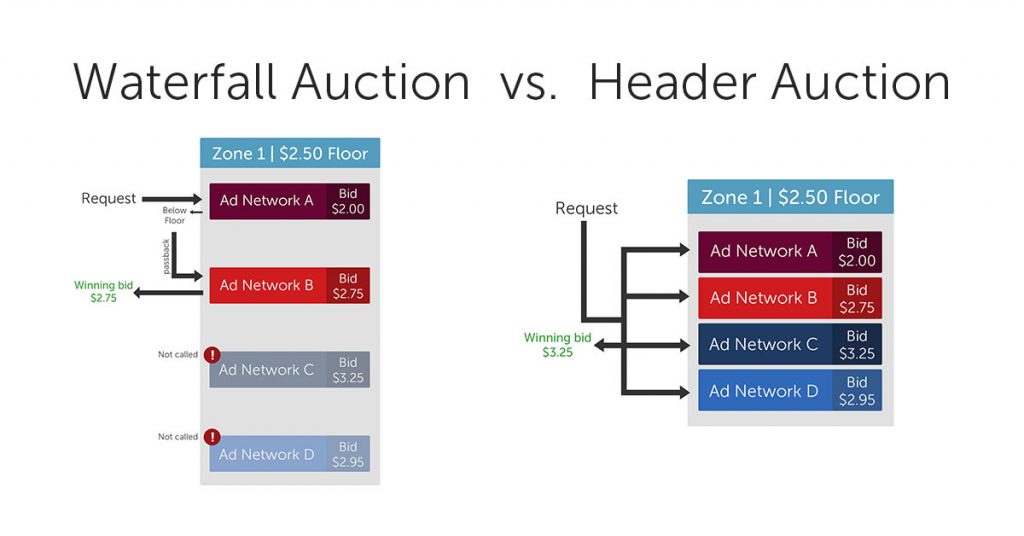Last updated on January 26th, 2023 at 04:10 pm
Has it not become a trend to explore, experiment, and break the conventions, to discover and invent? That has spread to all industries and sectors, and when the same fashion grew into the advertising sector, new platforms were created to ease the process. One such technological innovation is Header Bidding which eventually overcame the drawbacks of the Waterfall model. Waterfall, what you might know as the daisy chain or waterfall tags, is a process that a publisher makes use of to sell all remnant inventory. When a publisher has not been able to sell its premium ad slots that are usually reserved for direct ad sales between the publisher’s internal sales team and advertisers, Waterfall comes to its rescue. The process goes when demand sources are initiated one at a time, then one after another, and this recurring selling inventory is just why they are called Waterfall. Header Bidding is known to be a much cleaner and better tech integration between revenue partners, ad tech companies, and publishers relatively. One might also have heard of the same as advance bidding or pre-bidding, irrespective, it is an advanced programmatic technique, where publishers offer inventory to several ad exchanges simultaneously before making calls to their ad servers. The basic idea behind the same is that by letting a couple of demand sources bid at the same time, publishers may get an opportunity to increase their revenue. Here are we doing a comparative study between Header bidding vs waterfall from a publisher’s perspective.
Publishergrowth: The Revenue Acceleration Platform for Publishers
Blognife is elated to announce the launch of Publisher Growth- a community of publishers that helps you actively accelerate your revenue. This platform assists publishers in growing their traffic and revenue. As publishers, you can share and read reviews of ad networks and hosting companies. You can connect with other publishers to build links for growth and monetization hacks and more. This platform will help you stay up to date with the advertising and publisher ecosystem.

Features:
Header Bidding vs Waterfall: Benefits
Well, the ABCs of marketing dictates “Show me the money!” which is what the biggest benefit of header bidding is, that they have immense profits and merely adding a single header bid source can increase yield by 10 per cent. Other than that, if a publisher combines their inventory with a single SSP, they could sell inventory on a per-impression basis, which would provide them with more transparency into the worth of per impression. Well, the ABCs of marketing dictates “Show me the money!” which is what the biggest benefit of header bidding is, that they have immense profits and merely adding a single header bid source can increase yield by 10 per cent. Other than that, if a publisher combines their inventory with a single SSP, they could sell inventory on a per-impression basis, which would provide them with more transparency into the worth of per impression. However, in a traditional Waterfall model, the publisher has to set up the ad partners based on price priority levels and create passback tags so that if the demand from one partner is exhausted, it passes to the subsequent partners in the ad stack.
Header Bidding vs Waterfall: Ad Network Partners List
Header Bidding has a good number of partners, that they collaborate with and the same includes, including Criteo, Google(EBDA), Facebook, Amazon, AppNexus, Index Exchange, AOL Marketplace, Rubicon, OpenX and Centro. In a waterfall model, it is the publisher who is eligible to choose the list of partners based on the inventory type. Normally, at the top of the publisher ad stack are the direct advertisers and programmatic buyers which are followed by ad networks that have specific inventory requirements. At the end of the ad stack, the publisher monetizes the remnant inventory with Google Ad Exchange or similar partners which offers global coverage.
Header Bidding vs Waterfall: CPM Rates
There have been reports that suggest a 30%- 60% increase in revenue, before the use of header bidding. Though for that, one has to put in the effort, and work with the ideal number of header bidding partners, track them to keep the good ones and drop the bad ones, and in the process not neglect site latency. Pubmatic has seen gains as high as 50% on their publisher’s sites, owing to the latter. With Waterfall, an increase in the revenue is assured and the same is tiered. Even though the highest tiers receive the maximum revenues, they have really low fill rates. Though as it goes down the fill rates go up and the CPM rates decrease. Additionally, the loss of inventory with every passback is higher in the case of a Waterfall model when compared with Header bidding (due to latency).
Header Bidding vs Waterfall: Working Process

Header Bidding might seem a complicated process, but to put it out there for you, it basically is a simpler way, through which the publishers conduct direct auctions so that the inefficiencies are neglected and the best prices are sought for the ad space inventory. The web publisher puts some tech in the website’s header, and on the loading of a page on the site, the code reaches out to the supported ad exchange or the SSPs for bids before their own ad server’s direct sales are called. The bidding takes place simultaneously, rather than sequential, and focuses on all available impressions and not just the ones that are available after direct sales. If the case is so, that a publisher was unable to sell its direct buys because those generally yield the highest CPMs, then Waterfall could be of help, if the publisher passes the impression down the waterfall to various ad networks until it is sold. Their team would set up an ad network with a tracking tag that will execute if and when an impression is not filled, and the same is usually configured in platforms like Fallback Ads, Passbacks, Redirects, Default Ads, and the similar ones. Before that, the team would configure the premium ad network to pass back to the vertical ad network and so on. Here is the link to signup with a good header bidding SSP partner.
Conclusion
While both of these are fairly good and offer a good set of advantages, just like every coin, they too have two sides. Waterfall has its drawbacks even though it forbids wastage of an inventory, it does not give much of a yield. Other than that, loading each tier takes time and when the same happens, and as more time passes, there is a high probability of the user not being able to see the ad. That being said, header bidding increases the workload for publishers and they have to put in more effort, and other than that, it results in increased infrastructure costs.
Our Recommended Tools for Publishers:
- Best AdSense Alternative- Setupad, Ezoic
- Push Notification Network- iZooto, Unative,
- Best Contextual Ad Network- Media.net (Extra 10% for 3 months)
- Native Ad Network- Mgid
- Popup Ad Network- Exoclick, Propeller Ads
- Best Web Hosting- Bluehost, Hostgator, Stablehost, WPEngine
- Blogging Tools- OptinMonster, Astra, Teachable,

I and my team research various ad networks and can help you increase your overall ad revenue; so you could rake in more greenbacks with the best monetization platforms. Tap into the power of the online publishing business with me. I am just a mail away, so reach out to me if you want to scale up your website revenue. mail: [email protected]



1 thought on “Header Bidding vs Waterfall- A Publisher Perspective in 2023”